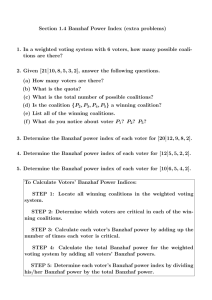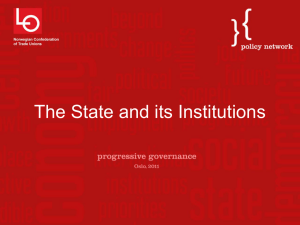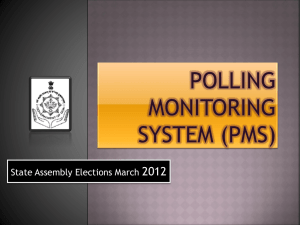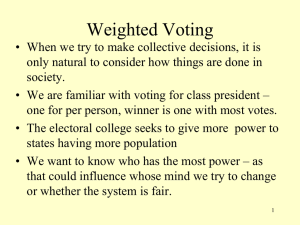Calculating Power in Large Systems
advertisement
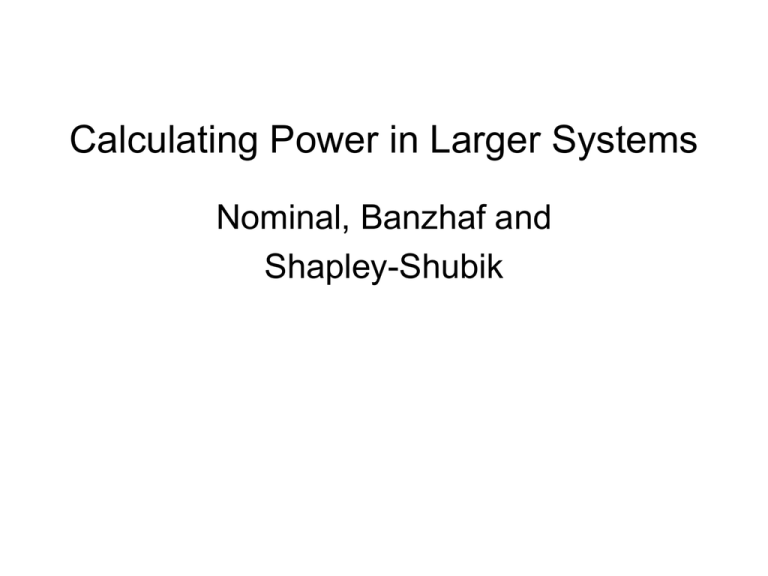
Calculating Power in Larger Systems Nominal, Banzhaf and Shapley-Shubik A Special Case • We will consider only one special case here: • All voters will have the same weight except one with a larger weight. • This technique is intended to be applied in the special case when there are 4 or more voters and listing every case would be more lengthy. Given [ 5: 3,1,1,1,1,1] • Here we have 6 voters and a quota of q = 5. • Calculate the nominal power, write as a percent. • (3/8, 1/8, 1/8, 1/8, 1/8, 1/8) = ( 38%, 12%, 12%, 12%, 12%, 12%). Given [ 5: 3,1,1,1,1,1] • Calculate Banzhaf measure of power, write in percent. • Name the voters A, B, C, D, E, F , and do power for A first. • A is critical when weight of coalition to which A belongs is 5 to 7. q q+A-1 w = 5: A + 1 + 1 can happen 5 choose 2 ways = 10 ways w = 6: A + 1 + 1 + 1 can happen 5 choose 3 ways = 10 ways w = 7: A + 1 + 1 + 1 + 1 can happen 5 choose 4 ways = 5 ways • There are 25 ways that A could be critical to a winning coalition, and therefore 25 ways that A could be critical to a blocking coalition. • So power Banzhaf power index for A is 25+25 = 50. Given [ 5: 3,1,1,1,1,1] • Next we calculate power for B only. The result will be the same for voters C, D, E and F… • B will be critical when belonging to a coalition with weight 5 only. w = 5: B + 1 + 1 + 1 + 1 can happen 4 choose 4 which is only 1 way. w = 5: B + A + 1 can happen 4 choose 1 = 4 ways. • Therefore B can be critical to win in 5 ways (and critical to block in 5 ways) and therefore has Banzhaf index 5 + 5 = 10. • So the Banzhaf index for this system is (50, 10, 10, 10, 10, 10) and writing the answer in percent form, we get (50%, 10%, 10%, 10%, 10%, 10%). Given [ 5: 3,1,1,1,1,1] • Calculate the Shapley-Shubik power index, write answer in percent form. • For Shapley-Shubik, the calculation for each voter is the number of times that voter is pivotal out of the total number of permutations. Therefore, when we have a large system with the special case that all voters are the same except one voter, we can take an additional shortcut in the calculations. • We only need to do one voter. For example, if we get the power of A (the voter with 3 votes), the remaining power is shared among the others and so we just divide the remaining power among the others – rather than compute the number of times the others are pivotal. It’s a little faster than doing the Banzhaf index for the large system – in this special case. Given [ 5: 3,1,1,1,1,1] • Calculate the Shapley-Shubik power index, write answer in percent form. • We calculate the power index for A – the voter with 3 votes. • Another shortcut is that for each of the 6 positions (because there are 6 voters total) in the list of voters that A could occupy as we list all permutations, we have the same number of permutations (it would be 5! = 120 in this case) of all the other identical voters. So we don’t really have to count that because it will remain the same throughout the calculation. • We just count in which of the 6 positions would A be pivotal? Given [ 5: 3,1,1,1,1,1] • We just count - in which of the 6 positions would A be pivotal? • • • • • • Case 1: Case 2: Case 3: Case 4: Case 5: Case 6: A11111 1A1111 11A111 111A11 1111A1 11111A - here A is not pivotal - again, A not pivotal - now A is pivotal - A is pivotal - A is pivotal - A is not pivotal (5 votes reached before A joins) • Conclusion: A is pivotal 3 out of 6 times, therefore has a ShapleyShubik power index of 3/6 which reduces to ½ and is equal 50%. • Next, we conclude that 50% of the power remains for the other voters, and because there are 5 (with equal votes) who will share it equally we get each has power 50%/5 = 10%. Given [ 5: 3,1,1,1,1,1] • So the Shapley-Shubik power index is (50%, 10%, 10%, 10%, 10%). • Now we can summarize: • Given the above weighted voting system, the measure of power among the voters is (depending on the method used) • Nominal power: ( 38%, 12%, 12%, 12%, 12%, 12%). • Banzhaf power: (50%, 10%, 10%, 10%, 10%, 10%). • Shapley-Shubik power: (50%, 10%, 10%, 10%, 10%, 10%).

